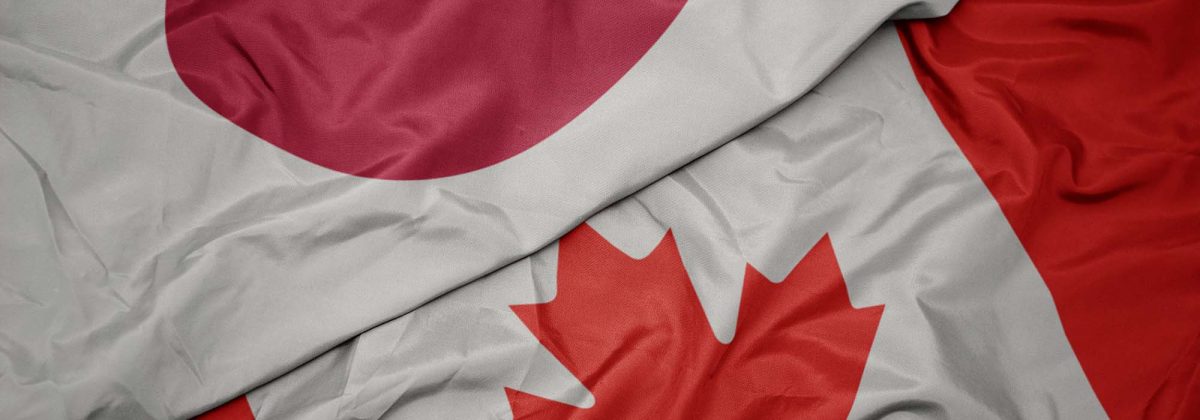The Benefits of the Deepening Canada Japan Trade Relationships

Canada and Japan celebrate 90 years of diplomatic relations in 2019. The history of bilateral diplomatic relations between the two countries dates back to 1928, when Japan established its consulate in Ottawa, and Canada launched its own diplomatic mission to Tokyo in May 1929.
Since then, the two countries have established strategic partnerships in various areas of their respective economies. Japan is Canada’s key trading partner in the Pacific, as well as the largest source of bilateral foreign direct investment (FDI) in Asia. FDI stock from Japan to Canada stood at US$29.6 billion in 2017, on account of approximately 450 Japanese companies and subsidiaries operating in Canada. This is much more than Canada’s share of FDI in Japan, which stood at some 100 companies operating on Japanese soil in key areas like automotive, financial services, information and communication technology and forestry services.
Exports from Canada to Japan amounted to US$12.9 billion in 2018, while Japan exported US$16.8 billion worth of goods to Canada. Economists and experts are now putting stress, more than ever, on the importance of a deepening trade relationship between the two countries. With the rise in protectionist measures adopted by the United States, key partnerships between two developed economies such as Japan and Canada, could be vital for global supply chains.
Canada and Japan Share Common Woes
The growing trade tensions between China and the United States is a major deterrent for global trade. The US is pursuing an “America First” philosophy, giving up multilateralism in favour of bilateralism. In order to negotiate strategic deals, the nation is imposing hefty tariffson a variety of goods, with assurances that these will be lifted once a trade deal has been agreed upon.
Its ongoing tussle with a large economy like China could lead to a cold-war type situation, which is a major threat to the global multilateral trading system. The world’s major economies could just decouple and shut their borders to other countries as a result.
A closure of the world economy is not a good thing for either Japan or Canada, which are unlikely to survive the after-effects, unlike the US, EU or China. This is why both countries have worked hard to keep the Comprehensive and Progressive Agreement on Trans-Pacific Partnership (CPTPP), formerly the TPP, alive, even when President Trump decided to pull out of it in 2017.
For Canada, it is an effort to lower its dependence on the US economy and diversify its trade options, while Japan wants to ensure that China is not the only key player in town for the BRI (China’s Belt Road and Initiative policy).
Both Canada and Japan stand to gain from each other, as they believe in establishing rule-based international multilateralism. They are both members of strategic alliances, like the G7, G20, Asia-Pacific Economic Cooperation, Asian Development Bank, International Monetary Fund and Organisation for Economic Co-operation and Development.
Japan is a net importer of energy and (until the recent past), the largest net importer of LNG globally. Canada can help Japan secure its energy requirements. On the other hand, Japan is a strategic entry point for Canada into vital South-East Asian and Asia-Pacific markets, a source of advanced technologies and critical investments for Canada’s economic benefits.
The CPTPP: Promise of a Symbiotic Association Benefitting World Economy
On December 30, 2018, the CPTPP came into force for the six countries that first chose to ratify it, including Canada and Japan. Once fully implemented, it will represent a trading bloc, engaging over 500 million people, with a combined GDP representing 13.5% of the global GDP.
What’s in it for Canada?
Canadians will be given preferential market access to this huge trading bloc. The tariff cuts recently made by Japan will offer Canadian goods a level playing field against other CPTPP competitors. For instance, Japan’s beef tariffs have been dropped from 38.5% to 26.6% and will be gradually reduced to 9%. This will give Canadian beef exports a competitive advantage against US beef suppliers.
The lifting of many non-trade barriers to trade will benefit the services sector. Temporary entry to the market has been made less complicated for Canadian professionals already. Until now, Canada had only established bilateral trade treaties with countries like Chile, Peru and Mexico. The revival of the CPTPP could help diversify the nation’s trade network, particularly as it stands to gain from its first-mover advantage. The US is still struggling to establish such treaties with Japan. Apart from the food-agri sector, other sectors where it will gain are:
- Defence
- Education
- Clean-tech
- Life Sciences
- Aerospace
How will Japan Benefit?
Japan’s overall economy is estimated to receive a boost of around $71 billion, once the CPTPP is fully implemented. It will set the stage for the ongoing Japan-USA FTA negotiations and also give the Asian economic giant an upper hand in the negotiations. Moreover, with Canada, Japan aims to promote security in the Korean peninsula. Canada has played a strategic role so far with Japan, to counter North Korea’s maritime sanction evasion. The CPTPP is a key to the survival of Japan’s Free and Open Indo-Pacific Strategy (FOIP), through which it wants to offer countries an alternative to China, in areas of technical assistance and development aid.
Advantage for the Global Economy: Countering the Chaotic Trade Environment
As links between superpowers are degrading in an era of global instability, the partnership between Japan and Canada could offer ways to mitigate some of the economic impact. Some CPTPP member countries, caught in the middle of the rising US-China trade tensions, can use the agreement to open up new export markets and various other options. In the worst-case scenario, where the ASEAN countries might have to choose between the west and the Chinese markets, the CPTPP countries will be able to bolster supply chains.
Influence on the CAD/JPY Pair
For currency traders, this represents unique trading opportunities in the CAD/JPY pair. Positive developments in Canada-Japan politics will drive the CAD/JPY pair higher. Cross-currency pairs, especially Yen crosses like CAD/JPY, are considered a suitable replacement for US Dollar currency pairs, during times of market volatility. Although not a major commodity pair, both currencies are strongly affected by commodity prices.
The price of energy commodities, especially crude oil price, affects the Canadian Dollar (CAD), while heavy metal prices impacts both. Higher yield of the Canadian Dollar makes it suitable for carry trade. Traders will, however, need to keep a watch on the health of the US economy, since both CAD and JPY have close ties to US trade.
With rising chances of volatility in the US Dollar, due to political instability and trade conflicts, the future prospects of CAD/JPY could be brighter. However, trading cross-pairs includes significant liquidity and volatility risks, which is why risk management strategies are essential.
Reference Links
- https://thebusinesscouncil.ca/publications/canada-and-japan-will-benefit-by-deepening-relations/
- https://www.edc.ca/en/blog/japan-rewards-canadian-companies.html
- https://www.canadainternational.gc.ca/japan-japon/bilateral_relations_bilaterales/index.aspx?lang=eng
- https://www.whitecase.com/publications/alert/cptpp-enters-force-what-does-it-mean-global-trade
- https://www.cigionline.org/articles/economic-strategy-canada-should-look-japan
- https://www.japantimes.co.jp/country-report/2019/07/01/canada-report-2019/canada-japan-celebrate-90-years/#.Xa1E8egzZPY







